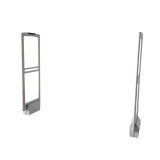Ever wondered how stores keep their items safe from sneaky hands? Enter EAS devices – the superheroes of retail security! These Electronic Article Surveillance gadgets might sound fancy. But they’re the secret guardians that prevent theft and protect goodies on store shelves. In this guide, we’ll unravel the mystery behind these cool gadgets. Explore why they’re a big deal in retail, and peek at the top 10 EAS devices! 🛒🔒
What are EAS Devices?
EAS devices, short for Electronic Article Surveillance, are a clever bunch of security systems used in stores to prevent theft and protect merchandise. These devices use different technologies like radio waves, magnetic fields, or RFID (Radio-Frequency Identification) to create a shield around valuable items.
They typically consist of tags or labels attached to products, detection antennas at store exits, and a central system to manage it all. When someone tries to sneak out without paying for an item, these tags trigger an alarm, alerting the staff and making the merchandise harder to steal.
Simply put, EAS devices act like a security blanket for stores, ensuring that only the purchased items make it out the door while the rest stay safe and sound on the shelves.
EAS devices’ applications span various industries, primarily preventing theft and enhancing security. Here are some key applications:
Applications of EAS Devices Across Industries
Retail Stores
- Theft Prevention: Retail stores extensively use EAS devices to deter shoplifting. Tags or labels attached to merchandise trigger alarms at exits if not deactivated properly, alerting staff to potential theft.
- Merchandise Protection: They safeguard high-value items like clothing, electronics, and accessories, reducing the risk of unauthorized removal.
Libraries and Media Stores
- Book and Media Protection: EAS devices help prevent unauthorized borrowing or theft of books, DVDs, and other media by securing them with tags or labels.
Supermarkets and Grocery Stores
- Preventing Grocery Item Theft: EAS systems protect high-value or commonly stolen items like alcohol, baby formula, or electronics in larger retail spaces.
Pharmacies and Drugstores
- Medicine and Health Product Security: EAS devices secure pharmaceuticals, high-value health products, and cosmetics to prevent theft or tampering.
Apparel and Fashion Outlets
- Clothing and Fashion Security: In stores, EAS tags widely protect clothing items, shoes, handbags, and other fashion accessories, ensuring clothing and fashion security.
Industrial and Manufacturing Facilities
- Inventory Protection: EAS devices can also be used in warehouses and manufacturing plants to secure inventory, machinery, and equipment.
Logistics and Supply Chain
- Cargo Security: EAS technology can safeguard shipments during transportation, ensuring products remain protected until they reach their destination.
Museums and Galleries
- Art and Artifact Protection: EAS systems help protect valuable artwork and artefacts from theft or unauthorized removal in museums and art galleries.
Electronic Goods Stores
- Protection of Electronics: EAS tags are applied to electronic devices like smartphones, tablets, and laptops to prevent theft and secure display models.
Sporting Goods and Specialty Stores
- Securing Specialty Items: EAS devices can be used in speciality stores to safeguard high-value items like sporting equipment, luxury goods, or collectables.
The Top 10 Types of EAS Devices
Let’s delve into the diverse world of EAS devices, each with its unique way of protecting merchandise.
Radio-Frequency (RF) Systems
- Utilizes RF tags and antennas to create a surveillance zone, triggering an alarm when a tagged item passes through without deactivation.
Acousto-Magnetic (AM) Systems
- Employs AM tags and detectors to generate an alarm when an item with an active tag moves through the surveillance area.
RFID (Radio-Frequency Identification) Tags and Systems
- Utilizes RFID technology for tracking and identification, often applied in retail for inventory management and security.
Electro-Magnetic (EM) Systems
- It uses EM tags and antennas to create a surveillance field, triggering an alarm if an active tag enters without deactivation.

Microwave Systems
- It operates on microwave frequencies and is commonly used in libraries and retail settings to protect books and media.
Magneto-Harmonic Tags
- Features tags utilizing harmonic resonance for detection, offering a stealthier anti-theft option for retailers.
Dual Technology EAS Tags
- Integrates multiple technologies like RF and AM in a single tag, enhancing system security and compatibility.
Infrared Systems
- It utilizes infrared light to create detection zones, commonly found in retail environments, for theft prevention.
Induction Systems
- Uses electromagnetic induction principles for detection, commonly applied in warehouses and industrial settings.
Signal Processing EAS Devices
- Utilizes advanced signal processing to enhance the accuracy and reliability of detection in various EAS systems.
Benefits and Applications of EAS Devices
EAS (Electronic Article Surveillance) devices offer many benefits across diverse industries, primarily centred around theft prevention and asset protection. Here’s a closer look at their advantages and applications:
- Theft Deterrence: EAS devices are a visible deterrent to potential shoplifters, reducing theft incidents and deterring unauthorized removal of merchandise.
- Improved Security: These systems enhance overall store security, providing protection against theft and minimizing losses due to shoplifting.
- Asset Protection: EAS tags and systems safeguard high-value items, reducing the risk of loss or damage to merchandise and preserving inventory.
- Alert Mechanisms: EAS systems generate audible or visual alerts when a tagged item leaves the premises without deactivation, notifying staff to take action.
- Versatility: EAS technology is adaptable across various industries, including retail stores, libraries, pharmacies, and museums, among others, ensuring wide-ranging applications.
- Enhanced Customer Experience: They offer a sense of security to customers, assuring them of protected merchandise and a safe shopping environment.
Conclusion
In conclusion, EAS devices are a pivotal guardian in retail security. Offering diverse systems that fortify merchandise protection and deter theft across various industries. From Radio-Frequency (RF) and Acousto-Magnetic (AM) systems to the innovation of RFID and advanced Signal Processing EAS Devices, these technologies are committed to enhancing security measures.
As retail environments evolve, reliable and adaptable EAS solutions become increasingly crucial. Asecuri, a trusted name in retail security solutions, epitomizes this commitment by providing cutting-edge EAS devices that safeguard merchandise. And contribute to an enhanced shopping experience for patrons. With its innovative range of EAS systems, Asecuri has positioned itself as a leader in fortifying security measures. Ensuring businesses can operate confidently while providing a safe and secure environment for merchandise and customers. As we stride into the future of retail security, Asecuri’s dedication to innovation remains integral in fortifying the defences against potential threats, safeguarding businesses, and fostering a secure retail landscape.


































